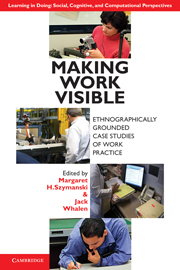Book contents
- Frontmatter
- Contents
- List of Figures and Excerpts
- List of Tables
- List of Contributors
- Series Foreword
- Foreword by John Seely Brown
- Acknowledgments
- Introduction
- Part I Work Practice Study in Historical Context
- Part II Applying Work Practice Methods
- Part III Practices around Documents
- Part IV The Customer Front
- Part V Learning and Knowledge Sharing
- 14 Communal Knowledge Sharing
- 15 Designing Document Solutions for Airline Maintenance Advisories
- 16 Transforming Information System Design
- 17 Rethinking How Projects Are Managed
- Part VI Competency Transfer
- References
- Index
- LEARNING IN DOING: SOCIAL, COGNITIVE AND COMPUTATIONAL PERSPECTIVES
16 - Transforming Information System Design
Enabling Users to Design
Published online by Cambridge University Press: 05 August 2012
- Frontmatter
- Contents
- List of Figures and Excerpts
- List of Tables
- List of Contributors
- Series Foreword
- Foreword by John Seely Brown
- Acknowledgments
- Introduction
- Part I Work Practice Study in Historical Context
- Part II Applying Work Practice Methods
- Part III Practices around Documents
- Part IV The Customer Front
- Part V Learning and Knowledge Sharing
- 14 Communal Knowledge Sharing
- 15 Designing Document Solutions for Airline Maintenance Advisories
- 16 Transforming Information System Design
- 17 Rethinking How Projects Are Managed
- Part VI Competency Transfer
- References
- Index
- LEARNING IN DOING: SOCIAL, COGNITIVE AND COMPUTATIONAL PERSPECTIVES
Summary
The IT industry used to be highly profitable with proprietary technologies. Over the years, however, as computing technologies have become open standard and modularized and largely commoditized through severe competition, the profits declined. Vendors sought profits from software services. However, large-scale software development, particularly custom software for a single client, is risky and costly. In this environment, IT vendors have been struggling to find ways to reduce risks, improve productivity, and secure profits.
Faced with these challenges, a large IT vendor and PARC started an ethnographic project to understand ways to become more competitive. In the beginning, the IT vendor asked us to study upstream activities in which engineers interact with their customers to develop specifications of the system. The relationships among the different players are summarized in Figure 16.1. There was recognition within the client organization – and in the industry – that this upstream phase was the source of most problems, which would often manifest themselves only in the later phases. For instance, when requirements are not defined precisely, the resulting system deviates from what users wanted and a major rework is needed. Rework simply adds unexpected work to project members' already tightly planned schedule. Rework causes more rework and worsens the situation. Members have to work until midnight or all night and over the weekend to get the work done. The schedule slips. Members burn out. This was a familiar story with the IT vendor.
- Type
- Chapter
- Information
- Making Work VisibleEthnographically Grounded Case Studies of Work Practice, pp. 299 - 311Publisher: Cambridge University PressPrint publication year: 2011

